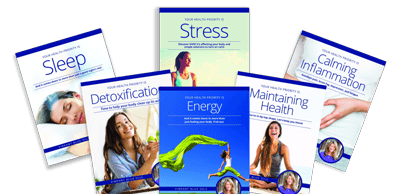When your nervous system is overwhelmed, it is harder to regulate emotions.
This means that minor stresses begin to feel like major problems, or every mole hill begins to feel like a mountain.
So when something goes sideways – be it a health hiccup, an unexpected work emergency, or a traffic jam that makes you late for an appointment – you might over-react in anger or shut down in paralysis.
In other words, your nervous system over-reacts, defaulting to fight or flight, where you feel angry, or under-reacts and freeze, where you feel overwhelmed and paralyzed.
The key to regulating emotions is regulating your nervous system.
Building parasympathetic tone supports your ability to calm both over-reaction and under-reaction so that you can regulate emotions and calm emotional states like anxiety, depression and other mood imbalances.
Parasympathetic Tone Shifts Perceived Stress and Stress Reactivity
Your perception of stress — or the degree to which situations in your life are perceived as stressful — and stress reactivity shifts as your nervous system regulates.
My favorite line from the Billy Joel Song “Summer Highland Falls” acutely captures stress perception and reactivity: “As we stand upon the ledges of our lives with our respective similarities – It’s either sadness or euphoria”
Every situation can be viewed through the lens of sadness or euphoria, often at the same time.
For example, the idea of my daughter leaving for college in the fall makes me both unbearably sad and at the same time, excited or euphoric for the next chapter I get to create in my life.
As I have worked to enhance my parasympathetic tone, I have noticed that my mood and ability to navigate perceived stressors seem to improve.
Measuring Perceived Stress
To help quantify this improvement in emotional regulation, I began assessing my perceived stress each week using the Perceived Stress Scale to assess how unpredictable, uncontrollable, and overloaded you feel your life to be. Perceived stress questions are rated on a scale of 1 – 5 (1-Never, 2-Almost Never, 3-Sometimes, 4-Fairly Often, 5-Very Often) and focus on if you have:
- Been upset because of something that happened unexpectedly?
- Felt that you were unable to control important things in your life?
- Felt nervous and ‘stressed’?
- Felt confident about your ability to handle your personal problems?
- Felt that things were going your way?
- Found that you could NOT cope with all the things you had to do?
- Been able to control irritations in your life?
- Felt that you were on top of things?
- Been angered because of things that happened that were out of your control?
- Felt difficulties were piling up so high that you could not overcome them?
The other assessment tool I have been playing with is the Hamilton Anxiety Rating Scale, one of the first rating scales developed to measure the severity of anxiety symptoms, including both psychic anxiety (mental agitation and psychological distress) and somatic anxiety (physical complaints related to anxiety), including:
- Anxious mood – Worries, anticipation of the worst, fearful anticipation, irritability.
- Tension – Feelings of tension, fatigability, startle response, moved to tears easily, trembling, feelings of restlessness, inability to relax.
- Fears – Feeling afraid of the dark, of strangers, of being left alone, of animals, of traffic, of crowds.
- Sleep – Difficulty in falling asleep or staying asleep, unsatisfying sleep and fatigue on waking, dreams, nightmares, night terrors.
- Cognition – Difficulty in concentration, poor memory, poor word recalt.
- Depressed mood – Loss of interest, lack of pleasure in hobbies, depression, early waking, diurnal swing (or morning depression).
- Somatic (muscular) – Pains and aches, twitching, stiffness, myoclonic jerks, grinding of teeth, unsteady voice, and increased muscular tone.
- Somatic (sensory) – Tinnitus, blurring of vision, hot and cold flushes, feelings of weakness, pricking sensation.
- Cardiovascular symptoms – Palpitations, pain in chest, throbbing of vessels, fainting feelings, missing heartbeat, tachycardia (heart rate over 100 beats a minute).
- Respiratory symptoms – Pressure or constriction in chest, choking feelings, sighing, dyspnea (difficult or labored breathing).
- Gastrointestinal symptoms – Difficulty in swallowing, wind abdominal pain, burning sensations, abdominal fullness, nausea, vomiting, borborygmi (a rumbling or gurgling noise made by the movement of fluid and gas in the intestines), looseness of bowels, loss of weight, constipation.
- Genitourinary (urinary and genital organs) symptoms – Frequency of urination, urgency of urination, amenorrhea (absence of menstruation), Menorrhagia (menstrual bleeding that lasts more than 7 days), development of frigidity, premature ejaculation, loss of libido, impotence.
- Autonomic symptoms – Dry mouth, flushing, pallor, tendency to sweat, giddiness, tension headache, raising of hair.
- Behavior – Fidgeting, restlessness or pacing, tremor of hands, furrowed brow, strained face, sighing or rapid respiration, pale skin
These two assessment tools have helped me recognize the symptoms of stress and track my ability to manage and calm it.
Regulating Your Nervous System to Regulate Emotions
Parasympathetic tone- or the ability to gear shift into the parasympathetic branch of the nervous system – is correlated with an enhanced capacity to regulate stress responses and mitigate mood and anxiety symptoms.
Research has found that vagus nerve stimulation decreases stress reactivity and anxiety-like behavior. More specifically, the Journal of Integrative and Complementary Medicine found that directly stimulating the vagus nerve increases parasympathetic tone leading to an improvement of autonomic regulation, cognitive functions, stress management and mood enhancement.
Improving your parasympathetic tone is believed to help increase your capacity for stress by regulate your set point, or threshold where a mole hill begins to feel like a mountain
Supporting parasympathetic tone helps support your ability to self regulate and bounce back more quickly from physical, mental and emotional stressors.
When you calm your nervous system, you also calm the release of chemicals that contribute to anxiety and overwhelm, like cortisol.
Increasing parasympathetic tone through vagus nerve stimulation has been shown to augment levels of cortisol and reduce anxiety in rats (Study) and improve scores on the Hamilton Anxiety Scale in patients suffering from treatment-resistant depression (Study).
Essential Oils for Parasympathetic Tone
Your vagus nerve can be stimulated to turns on the parasympathetic “rest and digest” nervous system.
The more you activate your parasympathetic nervous system, the more you build parasympathetic tone to help regulate emotions..
Essential oils are natural, non-invasive, easy tools to use to activate your vagus nerve. They possess both olfactory (smell) and transdermal (topical application) qualities, making them easy to inhale and apply on the skin to activate your vagus nerve.
Research backs this up as inhaling essential oils such as lavender or bergamot has been shown to activate your vagus nerve as measured by improved heart rate variability. Inhaled essential oils travel directly to your brain (specifically to the prefrontal cortex behind your forehead) where they can immediately help calm the fear response in your brain.
In addition, topically applied essential oils can cross the blood-brain barrier to stimulate your vagus nerve within the brain. Your skin is relatively permeable to fat-soluble substances like essential oils, making topical, or transdermal, application extremely effective. Topical application also bypasses the stomach and liver, which can chemically alter the therapeutic effects of drugs and essential oils.
It is important to note that different application points yield different results. You can significantly amplify your results by intentionally applying essential oils on specific healing points known as acupuncture points or reflexology points that are correlated with specific organ systems or regions of the brain, like the vagus nerve.
For example, acupuncture points behind the ear and around the neck are the most effective points for stimulating the vagus nerve. A neural anatomy study showed the vagus nerve is most accessible for stimulation via the lower half of the back ear. Research on “acupuncture and vagus nerve stimulation (VNS) found that acupuncture points produce clinical benefits through stimulation of the vagus nerve and/or its branches in the head and neck region that are anatomically proximate to vagus nerve pathways there, where the VNS electrode is surgically implanted.”
Topically applying stimulatory essential oils, like Parasympathetic®, behind the earlobe on the mastoid bone can stimulate the vagus nerve where it is most accessible to the surface of the skin to increase parasympathetic tone.
We recommend applying Parasympathetic® to vagus nerve three times daily, ideally before meals.
Featured Oil:
Ready to get started? Click the links below to order today:
References:
- https://www.das.nh.gov/wellness/docs/percieved%20stress%20scale.pdf
- https://www.ijoy.org.in/article.asp?issn=0973-6131;year=2016;volume=9;issue=2;spage=97;epage=113;aulast=Tyagi
- https://www.biologicalpsychiatryjournal.com/article/S0006-3223(11)00747-5/fulltext
- https://www.brainstimjrnl.com/article/S1935-861X(08)00003-X/fulltext
- https://pubmed.ncbi.nlm.nih.gov/24359451/
- https://pubmed.ncbi.nlm.nih.gov/25824404/




